Capturing the Footsteps of Mobility: A Machine Learning-Based Study on the Relationship Between Streetscape and Consumption Vitality
Abstract
1. Introduction
2. Materials and Methods
2.1. Study Area and Research Objects
2.2. Variable Selection and Measurement
2.2.1. Dependent Variable: Street Consumption Vitality
2.2.2. Independent Variable: Streetscape
2.2.3. Control Variables
2.3. Regression Model and Testing
3. Results
3.1. The Spatial Distribution Pattern of Street Consumption Vitality
3.2. Relationship Between Street Landscape and Consumption Vitality
3.2.1. Model Fit and Importance Analysis of Influencing Factors
3.2.2. Non-Linear Relationship Between Key Streetscape Factors and Street Consumption Vitality
3.2.3. Analysis of Interactions Between Key Streetscape Factors
4. Discussion
5. Conclusions
Author Contributions
Funding
Data Availability Statement
Conflicts of Interest
References
- Yang, F.F.; Lin, G.; Lei, Y.B.; Wang, Y.; Yi, Z. Understanding Urban Vitality from the Economic and Human Activities Perspective: A Case Study of Chongqing, China. Chin. Geogr. Sci. 2024, 34, 52–66. [Google Scholar] [CrossRef]
- Li, K.R.; Lin, Y. Exploring the Correlation between Streetscape and Economic Vitality Using Machine Learning: A Case Study in the Old Urban District of Xuzhou, China. ISPRS Int. J. Geo-Inf. 2023, 12, 267. [Google Scholar] [CrossRef]
- Lian, H.; Li, X.; Zhou, W.; Zhang, J.; Li, H. Pedestrian vitality characteristics in pedestrianized commercial streets-considering temporal, spatial, and built environment factors. Front. Archit. Res. 2024, 14, 630–653. [Google Scholar] [CrossRef]
- Zhang, X.; Du, L.; Song, X. Identification of Urban Renewal Potential Areas and Analysis of Influential Factors from the Perspective of Vitality Enhancement: A Case Study of Harbin City’s Core Area. Land 2024, 13, 1934. [Google Scholar] [CrossRef]
- Liu, X.; Tong, D.; Huang, J.; Zheng, W.; Kong, M.; Zhou, G. What matters in the e-commerce era? Modelling and mapping shop rents in Guangzhou, China. Land Use Policy 2022, 123, 106430. [Google Scholar] [CrossRef]
- Hillier, B. A theory of the city as object: Or, how spatial laws mediate the social construction of urban space. Urban Des. Int. 2002, 7, 153–179. [Google Scholar] [CrossRef]
- Hillier, B. Studying cities to learn about minds: Some possible implications of space syntax for spatial cognition. Environ. Plan. B Plan. Des. 2012, 39, 12–32. [Google Scholar] [CrossRef]
- Hillier, B. The Knowledge that Shapes The City: The Human City Beneath the Social City. In Proceedings of the 4th International Space Syntax Symposium, London, UK, 17 June 2003. [Google Scholar]
- Peng, C.; Jin, P. Consumer streets: Microscopic evidence of road density and consumption vitality. China Econ. Q. Int. 2023, 3, 60–75. [Google Scholar] [CrossRef]
- Kim, S.; Woo, A. Streetscape and business survival: Examining the impact of walkable environments on the survival of restaurant businesses in commercial areas based on street view images. J. Transp. Geogr. 2022, 105, 103480. [Google Scholar] [CrossRef]
- Izanloo, A.; Rafsanjani, A.K.; Ebrahimi, S.P. Effect of commercial land use and accessibility factor on traffic flow in Bojnourd. J. Urban Plan. Dev. 2017, 143, 05016016. [Google Scholar] [CrossRef]
- Ma, Z.; Li, C.; Zhang, P.; Zhang, J.; Liu, D.; Xie, M. The impact of transportation on commercial activities: The stories of various transport routes in Changchun, China. Cities 2023, 132, 103979. [Google Scholar] [CrossRef]
- Florida, R. Cities and the creative class. City Community 2003, 2, 3–19. [Google Scholar] [CrossRef]
- Martin, R.; Florida, R.; Pogue, M.; Mellander, C. Creativity, clusters and the competitive advantage of cities. Compet. Rev. 2015, 25, 482–496. [Google Scholar] [CrossRef]
- Rachmad, Y.E. The Future of Influencer Marketing: Evolution of Consumer Behavior in the Digital World; PT. Sonpedia Publishing: Jakarta, Indonesia, 2024. [Google Scholar]
- Abdel Monem, H. The effectiveness of advertising personalization. J. Des. Sci. Appl. Arts 2021, 2, 114–121. [Google Scholar] [CrossRef]
- Srivastava, M.; Kaul, D. Exploring the link between customer experience–loyalty–consumer spend. J. Retail. Consum. Serv. 2016, 31, 277–286. [Google Scholar] [CrossRef]
- Xie, Q.; Hu, L.; Wu, J.; Shan, Q.; Li, W.; Shen, K. Investigating the influencing factors of the perception experience of historical commercial streets: A case study of Guangzhou’s Beijing road pedestrian street. Buildings 2024, 14, 138. [Google Scholar] [CrossRef]
- Xu, Z. Effect of visual crowding in packaging on consumers’ buying intention. Asia Pac. J. Mark. Logist. 2024, 36, 293–314. [Google Scholar] [CrossRef]
- Kaplan, S. The role of natural environment aesthetics in the restorative experience. In Managing Urban and High-Use Recreation Settings; Forest Service, USDA: Washington, DC, USA, 1993; pp. 46–49. [Google Scholar]
- Kaplan, R. Impact of urban nature: A theoretical analysis. Urban Ecol. 1984, 8, 189–197. [Google Scholar] [CrossRef]
- Kaplan, R. The role of nature in the context of the workplace. Landsc. Urban Plan. 1993, 26, 193–201. [Google Scholar] [CrossRef]
- He, S.; Zhang, Z.; Yu, S.; Xia, C.; Tung, C.-L. Investigating the effects of urban morphology on vitality of community life circles using machine learning and geospatial approaches. Appl. Geogr. 2024, 167, 103287. [Google Scholar] [CrossRef]
- Wang, Z.; Wang, X.; Liu, Y.; Zhu, L. Identification of 71 factors influencing urban vitality and examination of their spatial dependence: A comprehensive validation applying multiple machine-learning models. Sustain. Cities Soc. 2024, 108, 105491. [Google Scholar] [CrossRef]
- Wu, J.; Lu, Y.; Gao, H.; Wang, M. Cultivating historical heritage area vitality using urban morphology approach based on big data and machine learning. Comput. Environ. Urban Syst. 2022, 91, 101716. [Google Scholar] [CrossRef]
- Chen, W.; Wu, A.N.; Biljecki, F. Classification of urban morphology with deep learning: Application on urban vitality. Comput. Environ. Urban Syst. 2021, 90, 101706. [Google Scholar] [CrossRef]
- Zhang, W.; Pan, S.; Li, Z.; Li, Z.; Dong, Z. The nonlinear relationship between air quality and housing prices by machine learning. Environ. Sci. Pollut. Res. 2023, 30, 114375–114390. [Google Scholar] [CrossRef] [PubMed]
- Dhumale, R.; Thombare, N.; Bangare, P. Machine learning: A way of dealing with Artificial Intelligence. In Proceedings of the 2019 1st International Conference on Innovations in Information and Communication Technology (ICIICT), Chennai, India, 25–26 April 2019; pp. 1–6. [Google Scholar]
- Kim, S.; Lee, S. Nonlinear relationships and interaction effects of an urban environment on crime incidence: Application of urban big data and an interpretable machine learning method. Sustain. Cities Soc. 2023, 91, 104419. [Google Scholar] [CrossRef]
- Xia, C.; Zhang, A.Q.; Yeh, A.G.O. The Varying Relationships between Multidimensional Urban Form and Urban Vitality in Chinese Megacities: Insights from a Comparative Analysis. Ann. Am. Assoc. Geogr. 2022, 112, 141–166. [Google Scholar] [CrossRef]
- Hipp, J.R.; Lee, S.; Ki, D.; Kim, J.H. Measuring the built environment with Google Street View and machine learning: Consequences for crime on street segments. J. Quant. Criminol. 2021, 38, 537–565. [Google Scholar] [CrossRef]
- Doan, Q.C.; Ma, J.; Chen, S.; Zhang, X. Nonlinear and threshold effects of the built environment, road vehicles and air pollution on urban vitality. Landsc. Urban Plan. 2025, 253, 105204. [Google Scholar] [CrossRef]
- Gu, X.; Zhu, L.; Liu, X. Examining the impact of urban environment on healthy vitality of outdoor running based on street view imagery and urban big data. J. Geogr. Sci. 2025, 35, 641–663. [Google Scholar] [CrossRef]
- Liu, M.; Yang, C.; Fan, Z.; Yuan, C. Prediction approach on pedestrian outdoor activity preference under factors of public open space integrated microclimate. Build. Environ. 2023, 244, 110761. [Google Scholar] [CrossRef]
- Nagata, S.; Nakaya, T.; Hanibuchi, T.; Amagasa, S.; Kikuchi, H.; Inoue, S. Objective scoring of streetscape walkability related to leisure walking: Statistical modeling approach with semantic segmentation of Google Street View images. Health Place 2020, 66, 102428. [Google Scholar] [CrossRef]
- Dong, G.; Yan, Y.; Shen, C.; Wang, H. Real-time high-performance semantic image segmentation of urban street scenes. IEEE Trans. Intell. Transp. Syst. 2020, 22, 3258–3274. [Google Scholar] [CrossRef]
- Wu, C.; Ye, Y.; Gao, F.Z.; Ye, X.Y. Using street view images to examine the association between human perceptions of locale and urban vitality in Shenzhen, China. Sustain. Cities Soc. 2023, 88, 104291. [Google Scholar] [CrossRef]
- Ma, Z. Deep exploration of street view features for identifying urban vitality: A case study of Qingdao city. Int. J. Appl. Earth Obs. Geoinf. 2023, 123, 103476. [Google Scholar] [CrossRef]
- Chen, M.; Cai, Y.; Guo, S.; Sun, R.; Song, Y.; Shen, X. Evaluating implied urban nature vitality in San Francisco: An interdisciplinary approach combining census data, street view images, and social media analysis. Urban For. Urban Green. 2024, 95, 128289. [Google Scholar] [CrossRef]
- Li, Y.; Yabuki, N.; Fukuda, T. Exploring the association between street built environment and street vitality using deep learning methods. Sustain. Cities Soc. 2022, 79, 103656. [Google Scholar] [CrossRef]
- Shi, Y.; Tao, T.; Cao, X.; Pei, X. The association between spatial attributes and neighborhood characteristics based on Meituan take-out data: Evidence from shanghai business circles. J. Retail. Consum. Serv. 2021, 58, 102302. [Google Scholar] [CrossRef]
- Wang, Q.; Tang, D. Research on intelligent recommendation business model of tourism enterprise value platform from the perspective of value cocreation. Complexity 2021, 2021, 8441844. [Google Scholar] [CrossRef]
- Biljecki, F.; Ito, K. Street view imagery in urban analytics and GIS: A review. Landsc. Urban Plan. 2021, 215, 104217. [Google Scholar] [CrossRef]
- Cheng, B.; Misra, I.; Schwing, A.G.; Kirillov, A.; Girdhar, R. Masked-attention mask transformer for universal image segmentation. In Proceedings of the IEEE/CVF conference on computer vision and pattern recognition, Denver, CO, USA, 3–7 June 2022; pp. 1290–1299. [Google Scholar]
- Lv, G.; Zheng, S.; Hu, W. Exploring the relationship between the built environment and block vitality based on multi-source big data: An analysis in Shenzhen, China. Geomat. Nat. Hazards Risk 2022, 13, 1593–1613. [Google Scholar] [CrossRef]
- Dormann, C.F.; Elith, J.; Bacher, S.; Buchmann, C.; Carl, G.; Carré, G.; Marquéz, J.R.G.; Gruber, B.; Lafourcade, B.; Leitão, P.J. Collinearity: A review of methods to deal with it and a simulation study evaluating their performance. Ecography 2013, 36, 27–46. [Google Scholar] [CrossRef]
- Uyanık, G.K.; Güler, N. A study on multiple linear regression analysis. Procedia-Soc. Behav. Sci. 2013, 106, 234–240. [Google Scholar] [CrossRef]
- Prathanrat, P.; Polprasert, C. Performance prediction of Jupyter notebook in JupyterHub using machine learning. In Proceedings of the 2018 International Conference on Intelligent Informatics and Biomedical Sciences (ICIIBMS), Bangkok, Thailand, 21–24 October 2018; pp. 157–162. [Google Scholar]
- Chicco, D.; Warrens, M.J.; Jurman, G. The coefficient of determination R-squared is more informative than SMAPE, MAE, MAPE, MSE and RMSE in regression analysis evaluation. Peerj Comput. Sci. 2021, 7, e623. [Google Scholar] [CrossRef]
- Ji, Y.; Wang, Z.; Zhu, D. Exploring the Impact of Urban Amenities on Business Circle Vitality Using Multi-Source Big Data. Land 2024, 13, 1616. [Google Scholar] [CrossRef]
- Öner, Ö. Retail city: The relationship between place attractiveness and accessibility to shops. Spat. Econ. Anal. 2017, 12, 72–91. [Google Scholar] [CrossRef]
- Loodin, H.; Thufvesson, O. Which architectural style makes an attractive street scape? Aesthetic preferences among city centre managers. J. Urban Des. 2023, 28, 25–43. [Google Scholar] [CrossRef]
- Carmona, M. Public Places Urban Spaces: The Dimensions of Urban Design; Routledge: London, UK, 2021. [Google Scholar]
- Xiangmin, G.; Weiqiang, C.; Tiantian, L.; Shumeng, H. Research on dynamic visual attraction evaluation method of commercial street based on eye movement perception. J. Asian Archit. Build. Eng. 2022, 21, 1779–1791. [Google Scholar] [CrossRef]
- Li, X.; Li, Y.; Jia, T.; Zhou, L.; Hijazi, I.H. The six dimensions of built environment on urban vitality: Fusion evidence from multi-source data. Cities 2022, 121, 103482. [Google Scholar] [CrossRef]
- Markvica, K.; Richter, G.; Lenz, G. Impact of urban street lighting on road users’ perception of public space and mobility behavior. Build. Environ. 2019, 154, 32–43. [Google Scholar] [CrossRef]
- Tang, X.; Li, X.; Hao, Z. The impact of live background visual complexity on consumer purchase intention: An eye-tracking study. Asia Pac. J. Mark. Logist. 2024, 36, 2539–2557. [Google Scholar] [CrossRef]
- Yue, H.; Zhu, X. Exploring the relationship between urban vitality and street centrality based on social network review data in Wuhan, China. Sustainability 2019, 11, 4356. [Google Scholar] [CrossRef]
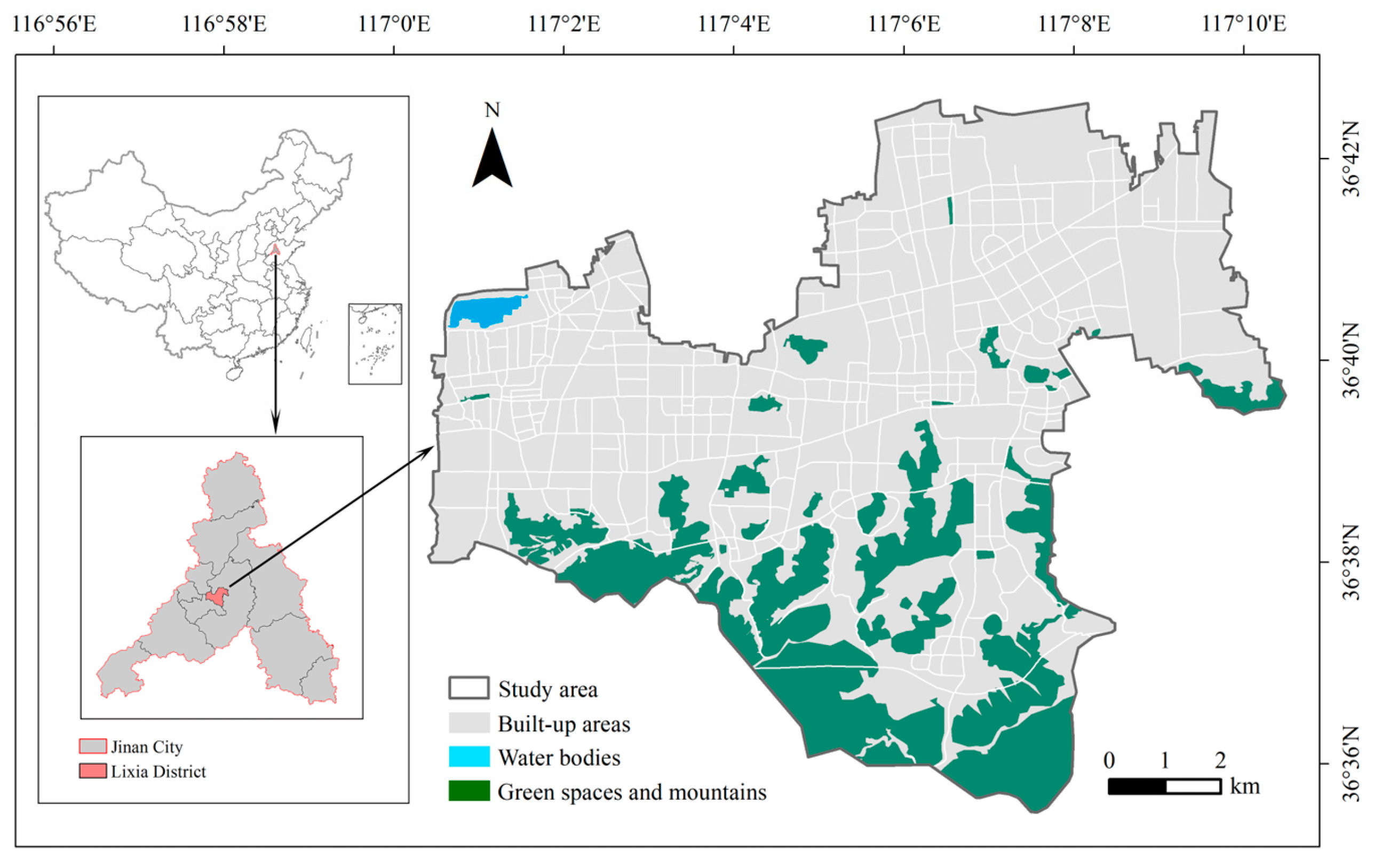

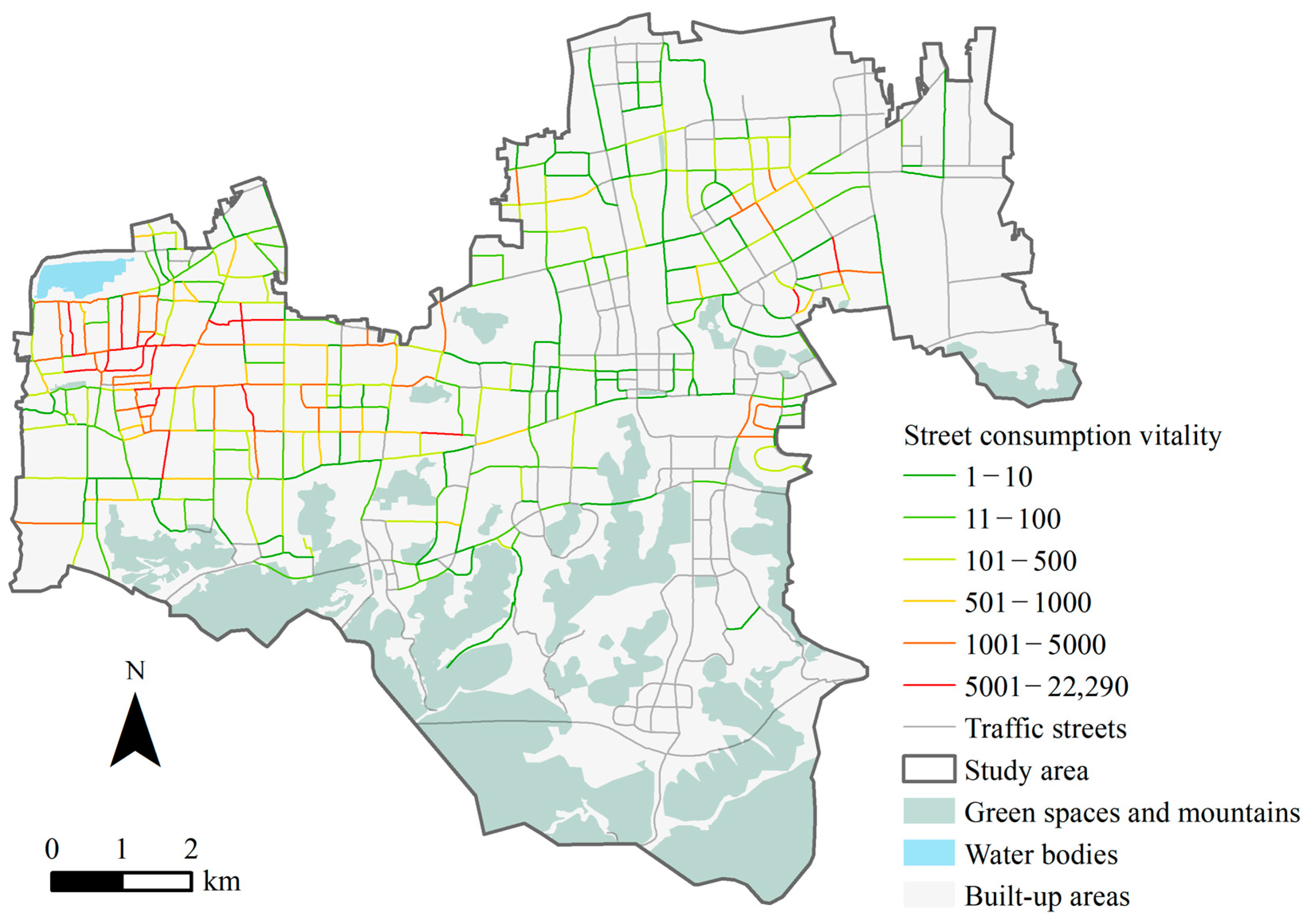
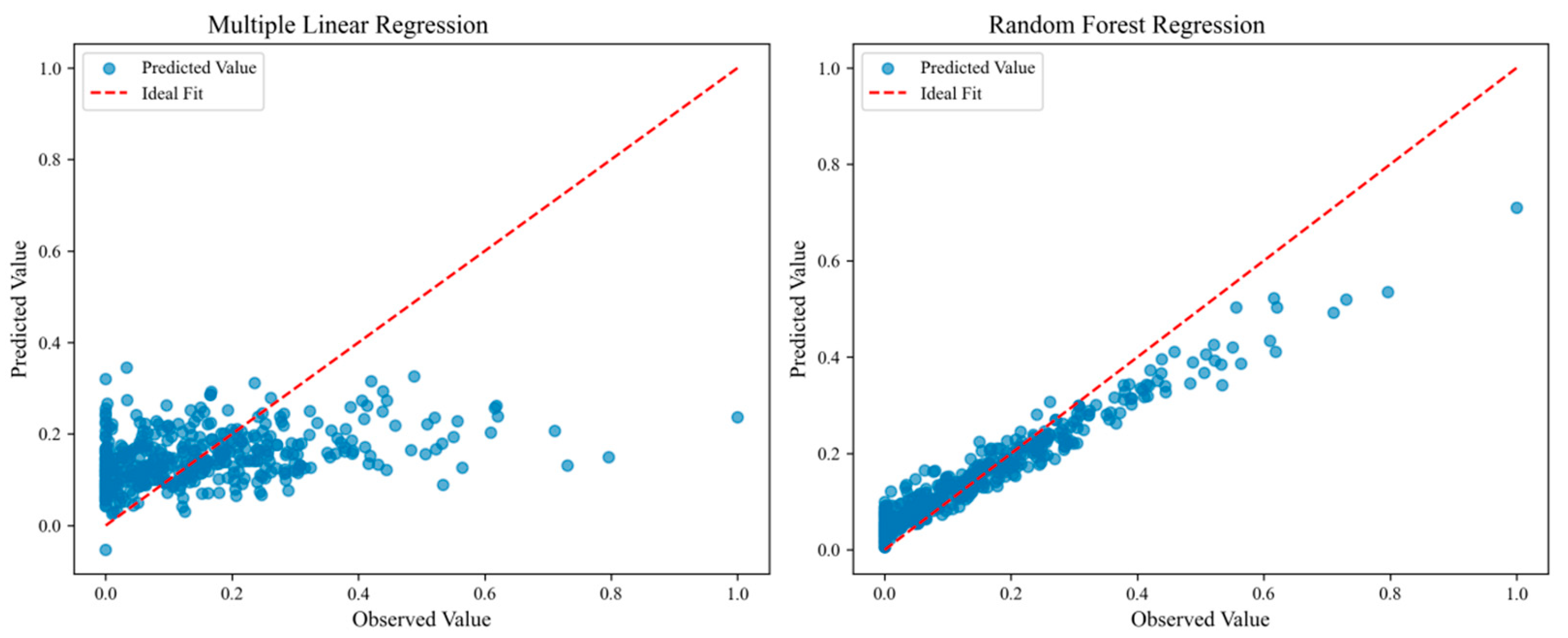
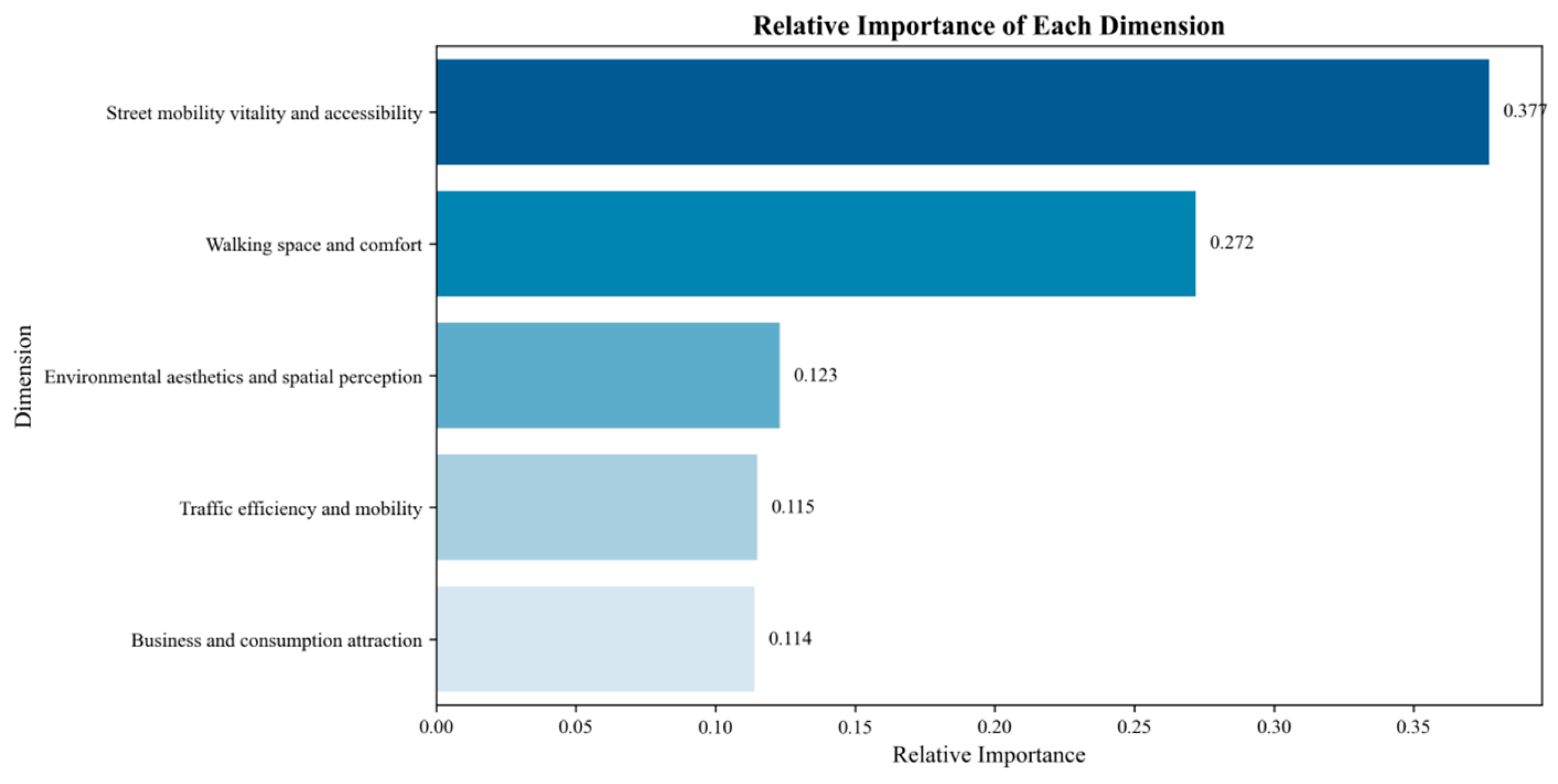
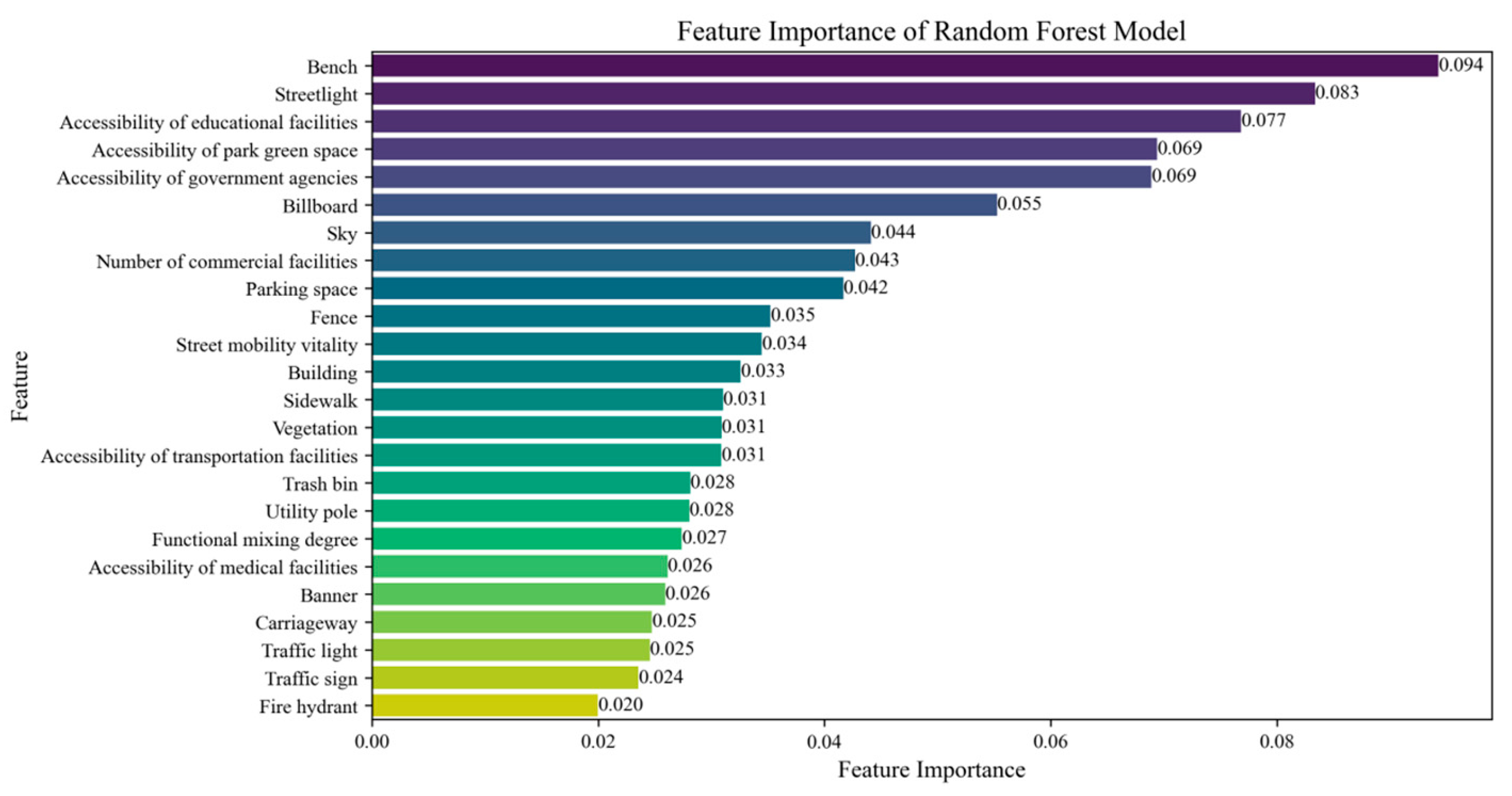
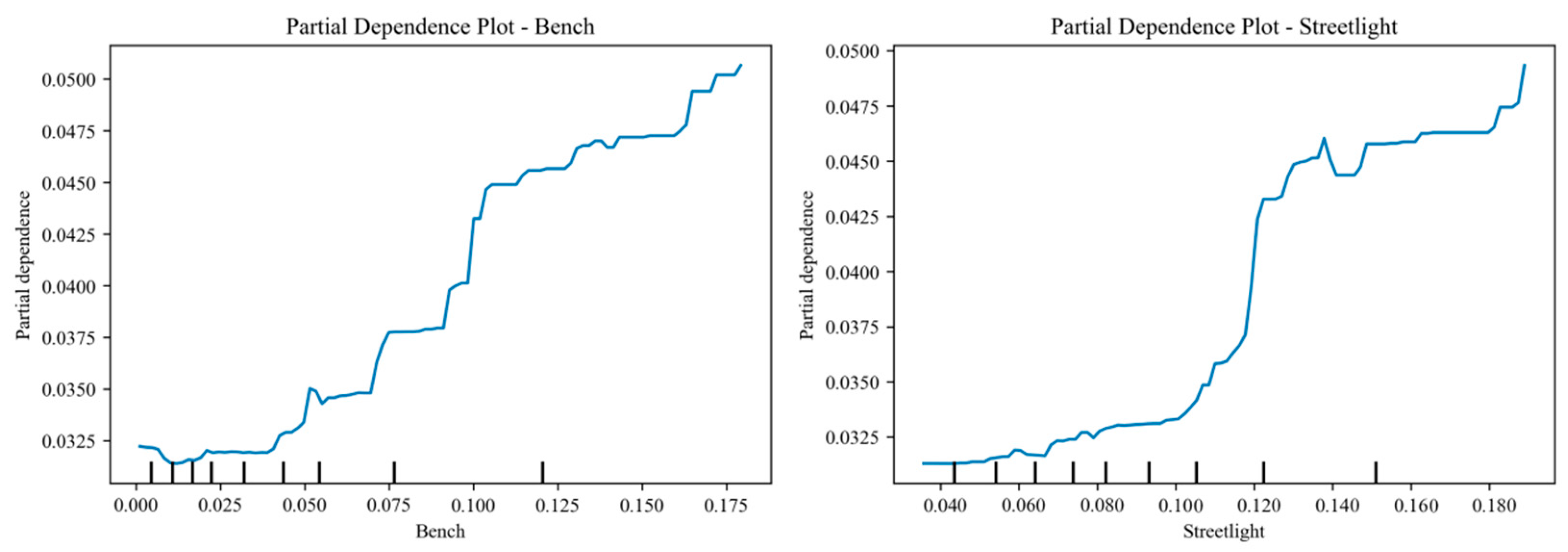

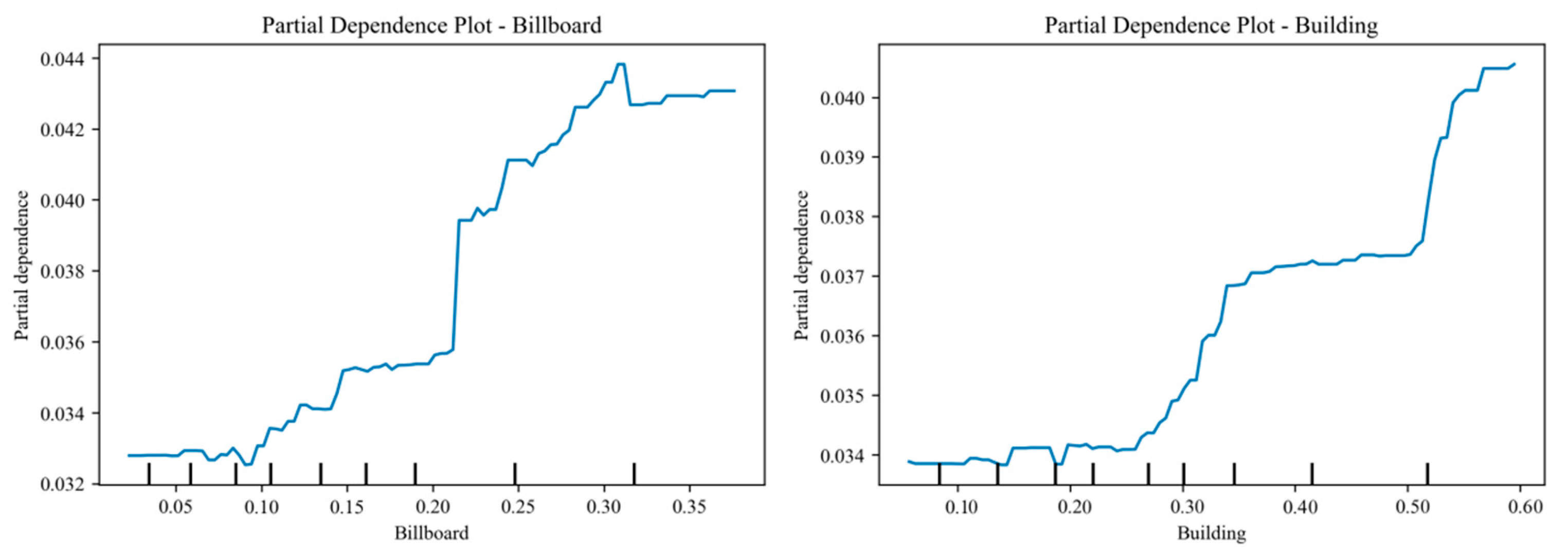
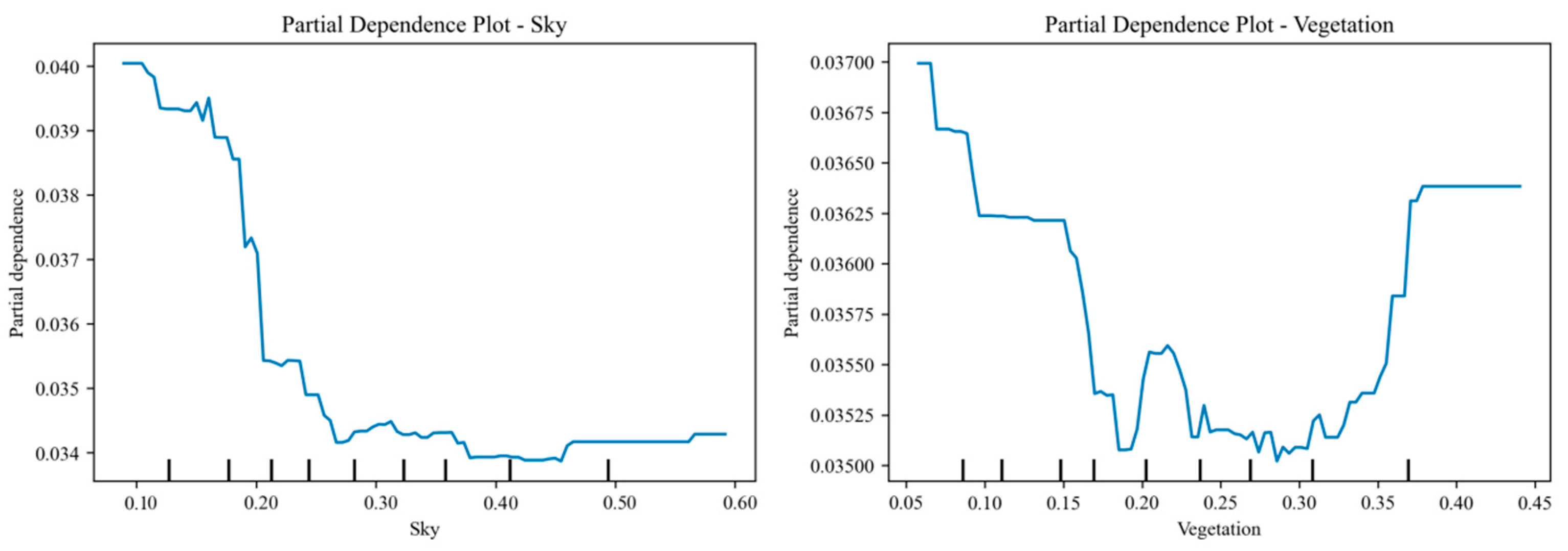

| Parameter Name | Default Value | Description | Set Value |
|---|---|---|---|
| ak | null | User’s access key | Obtain personal access key |
| location | null | Coordinates of the panoramic location | Sampling point Baidu coordinates |
| coordtype | bd0911 | Coordinate system of the panoramic location | Baidu coordinate system bd0911 |
| heading | 0 | Horizontal angle, range [0, 360] | 0, 90, 180, 270 |
| pitch | 0 | Vertical angle, range [0, 90] | 0 |
| fovy | 90 | Field of view angle, range [0, 360] | 90 |
| width | 400 | Image width | 400 |
| height | 300 | Image height | 300 |
Disclaimer/Publisher’s Note: The statements, opinions and data contained in all publications are solely those of the individual author(s) and contributor(s) and not of MDPI and/or the editor(s). MDPI and/or the editor(s) disclaim responsibility for any injury to people or property resulting from any ideas, methods, instructions or products referred to in the content. |
© 2025 by the authors. Published by MDPI on behalf of the International Society for Photogrammetry and Remote Sensing. Licensee MDPI, Basel, Switzerland. This article is an open access article distributed under the terms and conditions of the Creative Commons Attribution (CC BY) license (https://creativecommons.org/licenses/by/4.0/).
Share and Cite
Hou, Y.; Zhang, X.; Jia, J. Capturing the Footsteps of Mobility: A Machine Learning-Based Study on the Relationship Between Streetscape and Consumption Vitality. ISPRS Int. J. Geo-Inf. 2025, 14, 422. https://doi.org/10.3390/ijgi14110422
Hou Y, Zhang X, Jia J. Capturing the Footsteps of Mobility: A Machine Learning-Based Study on the Relationship Between Streetscape and Consumption Vitality. ISPRS International Journal of Geo-Information. 2025; 14(11):422. https://doi.org/10.3390/ijgi14110422
Chicago/Turabian StyleHou, Yiming, Xiaoqing Zhang, and Jia Jia. 2025. "Capturing the Footsteps of Mobility: A Machine Learning-Based Study on the Relationship Between Streetscape and Consumption Vitality" ISPRS International Journal of Geo-Information 14, no. 11: 422. https://doi.org/10.3390/ijgi14110422
APA StyleHou, Y., Zhang, X., & Jia, J. (2025). Capturing the Footsteps of Mobility: A Machine Learning-Based Study on the Relationship Between Streetscape and Consumption Vitality. ISPRS International Journal of Geo-Information, 14(11), 422. https://doi.org/10.3390/ijgi14110422






